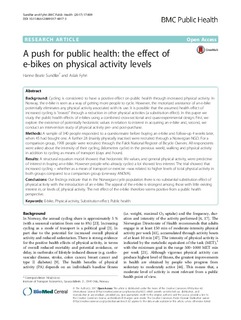| dc.contributor.author | Sundfør, Hanne Beate | |
| dc.contributor.author | Fyhri, Aslak | |
| dc.coverage.spatial | Norway | nb_NO |
| dc.date.accessioned | 2019-07-04T08:51:41Z | |
| dc.date.available | 2019-07-04T08:51:41Z | |
| dc.date.created | 2017-11-28T14:35:34Z | |
| dc.date.issued | 2017-10-16 | |
| dc.identifier.citation | BMC Public Health. 2017, 17 (809), 1-12. | nb_NO |
| dc.identifier.issn | 1471-2458 | |
| dc.identifier.uri | http://hdl.handle.net/11250/2603369 | |
| dc.description.abstract | Background Cycling is considered to have a positive effect on public health through increased physical activity. In Norway, the e-bike is seen as a way of getting more people to cycle. However, the motorized assistance of an e-bike potentially eliminates any physical activity associated with its use. It is possible that the assumed health effect of increased cycling is “erased” through a reduction in other physical activities (a substitution effect). In this paper we study the public health effects of e-bikes using a combined cross-sectional and quasi-experimental design. First, we explore the existence of potentially hedonistic values in relation to interest in acquiring an e-bike and, second, we conduct an intervention study of physical activity pre- and post-purchase. Methods A sample of 340 people responded to a questionnaire before buying an e-bike and follow-up 4 weeks later, when 45 had bought one. A further 28 (mainly physically inactive) were recruited through a Norwegian NGO. For a comparison group, 1995 people were recruited through the Falck National Register of Bicycle Owners. All respondents were asked about the intensity of their cycling, (kilometres cycled in the previous week), walking and physical activity in addition to cycling as means of transport (days and hours). Results A structural equation model showed that hedonistic life values, and general physical activity, were predictive of interest in buying an e-bike. However people who already cycled a lot showed less interest. The trial showed that increased cycling – whether as a mean of transport or exercise –was related to higher levels of total physical activity in both groups compared to a comparison group (one-way ANOVA). Conclusions Our findings indicate that in the Norwegian cycle population there is no substantial substitution effect of physical activity with the introduction of an e-bike. The appeal of the e-bike is strongest among those with little existing interest in, or levels of, physical activity. The net effect of the e-bike therefore seems positive from a public health perspective. | nb_NO |
| dc.language.iso | eng | nb_NO |
| dc.publisher | Springer Nature | nb_NO |
| dc.rights | Navngivelse 4.0 Internasjonal | * |
| dc.rights.uri | http://creativecommons.org/licenses/by/4.0/deed.no | * |
| dc.title | A push for public health: the effect of e-bikes on physical activity levels | nb_NO |
| dc.type | Journal article | nb_NO |
| dc.type | Peer reviewed | nb_NO |
| dc.rights.holder | © The Author(s). 2017 | nb_NO |
| dc.description.version | publishedVersion | nb_NO |
| cristin.unitcode | 7482,2,2,0 | |
| cristin.unitname | Sikkerhet og atferd | |
| cristin.ispublished | true | |
| cristin.fulltext | original | |
| cristin.qualitycode | 1 | |
| dc.identifier.doi | 10.1186/s12889-017-4817-3 | |
| dc.identifier.cristin | 1519668 | |
| dc.source.journal | BMC Public Health | nb_NO |
| dc.source.volume | 17 | nb_NO |
| dc.source.issue | 809 | nb_NO |
| dc.source.pagenumber | 1-12 | nb_NO |
| dc.relation.project | Norges forskningsråd: 225867 | nb_NO |

